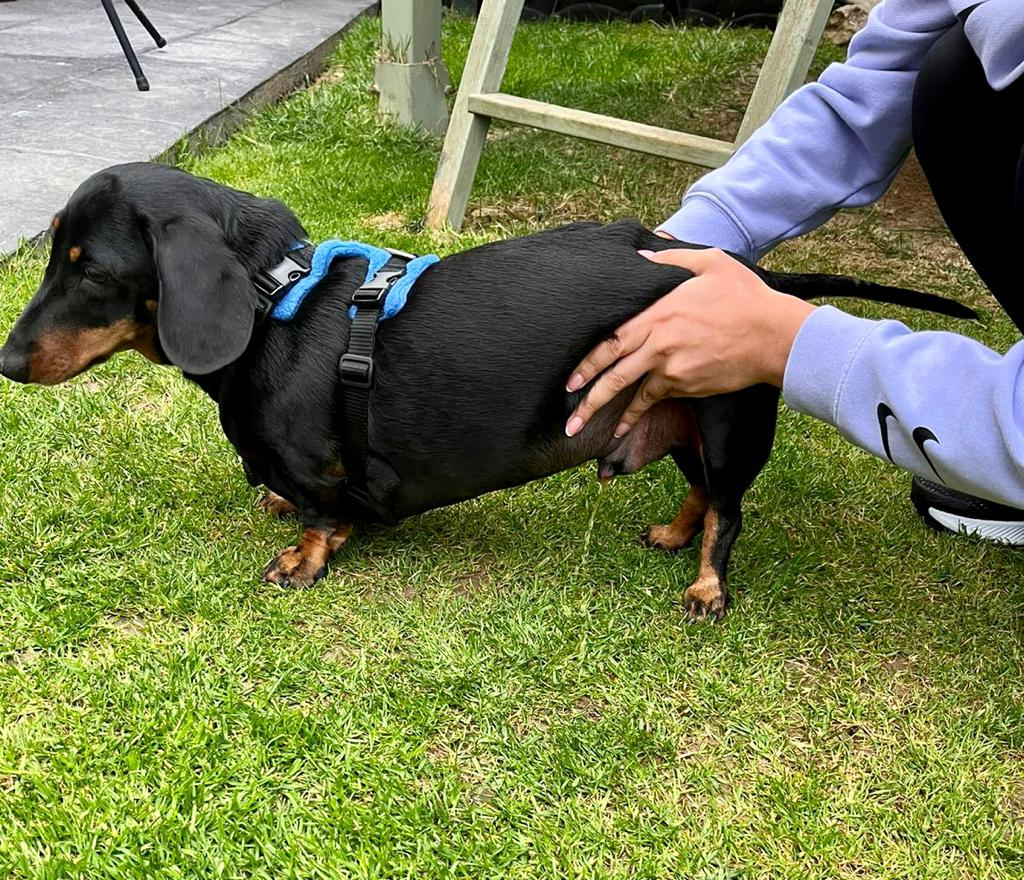When is bladder expression needed?
If your IVDD-affected dog is not managing to pee on their own, your vet may ask you to express (squeeze out) their bladder. The aim is to get your dog through these tricky few days to weeks by emptying their bladder regularly. Hopefully they’ll eventually manage to pee on their own again. It’s important not to let the bladder become so full that it’s overstretched, as this can cause it some long term damage.
How to express your dog’s bladder
The basic technique for emptying the bladder is quite straightforward. Always give your dog a good chance to pee naturally first (carry them to a suitable patch of ground outside, and let him walk on a lead for up to a few minutes, with support from a hindquarter sling if needed). To express the bladder, Start with your dog positioned on a non-slip surface in a supported standing position. Most people find it easier to use two hands to express their dog’s bladder to start with, so have someone else there to distract him from in front. Place a hand on each side of your dog’s belly, and use the flat parts of your hands to apply slow, steady pressure to empty the bladder. Avoid digging your fingertips in, or trying to overpower your dog. For a demonstration, try this link.
Above: It’s best to support your dog in a standing position while expressing your bladder.
In some dogs, the bladder is full but it simply won’t empty even with quite firm pressure. In which case take your hands off, let your dog relax for a moment, then try again. If you still can’t express your dog’s bladder, then ask your vet what to do. Your dog might need medication to make it easier for the bladder to empty. Or your vet may need to pass a catheter into the bladder so as to empty it. In the early stages, it’s sometimes necessary to admit the dog to the hospital and have a catheter kept in place for a few days (an indwelling catheter).
Where to express your dog’s bladder
The best place to express your dog’s bladder is on the ground outdoors, with your dog supported in a standing position on soil, bark chips or short grass. Expressing the bladder outdoors will help your dog to associate peeing with being outdoors, thus helping them return to normal function more easily.
If you must express your dog’s bladder indoors, stand them on an incontinence pad, or have them resting or supported standing on a non-slip mat while you express their bladder into a dish or onto some disposable padding. Don’t dangle your dog over a drain, toilet or sink while expressing his bladder. A dangling position leaves them feeling helpless and may be unsafe for their spine.
As the IVDD inflammation settles down, your dog will hopefully start to be able to control their own pee again. This may take days, weeks or even months, but it’s important to help your dog learn. Set them up for success by doing the bladder expression with your dog supported in a standing position, ideally on a suitable patch of ground outdoors.
Further information to help your dog during IVDD recovery
The IVDD Handbook is a comprehensive home care guide for dogs with IVDD (disc extrusion or ‘slipped disc’). It’s also suitable for those with certain other back or neck problems including FCE and traumatic disc. Use this book in conjunction with talking to your own vet. It contains:
- clear practical guidelines for each stage of recovery
- illustrated how-to guides for everything from sling-walking to home exercises
- notes on when to contact your vet
- a whole section on solving practical toileting issues during recovery
- an illustrated guide to understanding your dog’s surgical report
- advice on keeping your recovering dog happy and content
- a section on maintaining your own wellbeing while caring for your own dog
- example daily routines suitable for dogs at each stage of recovery
- hundreds of colour photos showing what to look for and how to help your dog
- an index, glossary and colour-coded chapter to help you find information fast.
How to get your copy
Click here to buy or look inside The IVDD Handbook.
The above link should redirect you to your country’s Amazon site.
Order the book to be delivered to you from the US if you live in Australia, New Zealand or Singapore. For further details, click here.
Links to the book on this page are provided as part of the Amazon Associates program. Buying the book after clicking on one of these links will earn the author a small commission, thus contributing to the ongoing running of this website.
Booking an appointment
For bespoke supervision of your own dog’s recovery, you are welcome to contact me to arrange a video consultation appointment. To book an appointment, use the contact form here or email me at [email protected]. I’ll get back to you as soon as I can. Please note that these contact details are for appointments only. I offer home visit appointments, when appropriate, for dogs and cats living near me in North Herts, UK. Video consultations are available for both local and distant patients.



Comments are closed